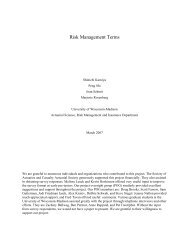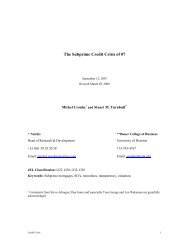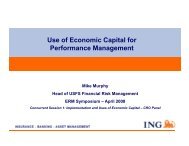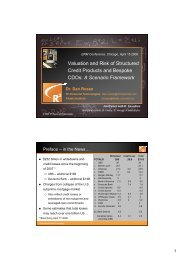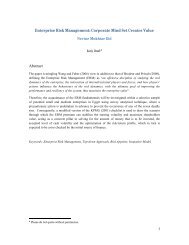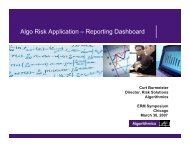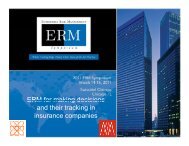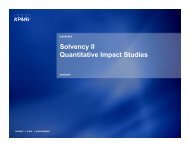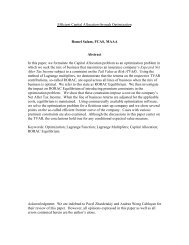Bayesian Risk Aggregation: Correlation ... - ERM Symposium
Bayesian Risk Aggregation: Correlation ... - ERM Symposium
Bayesian Risk Aggregation: Correlation ... - ERM Symposium
You also want an ePaper? Increase the reach of your titles
YUMPU automatically turns print PDFs into web optimized ePapers that Google loves.
expert knowledge regarding the inter-risk-correlation matrix in probabilistic form. Since<br />
our example portfolio consists of d = 4 risk types, it is sufficient to consider 4×4 correlation<br />
matrices R, which can be identified with a 6-dimensional real vector by<br />
⎛<br />
⎞<br />
⎜<br />
R = ⎜<br />
⎝<br />
1 r1 r2 r3<br />
· 1 r4 r5<br />
· · 1 r6<br />
· · · 1<br />
⎟<br />
⎠ ←→ (r1, r2, r3, r4, r5, r6), ri ∈ [−1, 1], 1 ≤ i ≤ 6. (3.1)<br />
The most commonly used prior model for a covariance matrix Σ is the inverse-Wishart<br />
distribution, see e.g. Press [20]. Since every covariance matrix Σ is related to a correlation<br />
matrix R by<br />
Σ = S 1/2 R S 1/2 , (3.2)<br />
where S = diag(σ11, σ22, . . .) and σjj are the diagonal elements of Σ, the inverse-Wishart<br />
prior can also be used to construct a prior for the correlation matrix.<br />
The inverse-Wishart-based prior for the inter-risk-correlation matrix allows only for<br />
one single degrees of freedom parameter ν to express prior beliefs (and thus the level of<br />
uncertainty) about R. In practice, however, the amount of available expert information<br />
for different pair correlations ri, i = 1, . . . , 6, may significantly depend on the risk-type<br />
combinations. Another drawback of the inverse-Wishart distribution is that the resulting<br />
prior for R cannot easily be estimated by means of expert judgement. Note, that the<br />
prior distribution for R is calculated from the inverse-Wishart prior for Σ through trans-<br />
formation (3.2), which rarely yields a prior distribution that can easily be specified by<br />
expert elicitation. All this leads to the conclusion that the inverse-Wishart based prior is<br />
inadequate for our purpose and that we have to construct a more flexible prior for R.<br />
Thus we have decided to use a kind of “bottom-up” approach when building the prior<br />
distribution for the inter-risk-correlation matrix. In a first step, prior information for each<br />
component ri, i = 1, . . . , 6, of R is separately modelled by one-dimensional distributions<br />
with Lebesgue densities πi(ri), i = 1, . . . , 6. This yields a distribution of symmetric, real-<br />
valued matrices with diagonal elements equal to one. In a second step we restrict to<br />
those matrices preserving the positive semidefiniteness of the correlation matrix. Hence,<br />
denoting the space of all 4-dimensional correlation matrices by R 4 , a possible density for<br />
the correlation matrix prior can be written as<br />
π(R) = <br />
πi(ri) 1 {R∈R4 }. (3.3)<br />
1≤i≤6<br />
The indicator function 1{·} ensures that the matrices are positive definite and thus are<br />
proper correlation matrices, and also introduces a dependence structure among the ri for<br />
i = 1, . . . , 6.<br />
7



